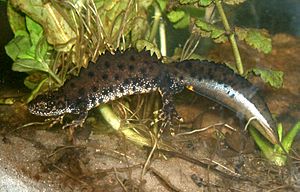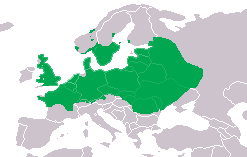Great crested newt facts for kids
Quick facts for kids Northern crested newt |
|
|---|---|
 |
|
| Male great crested newt in "mating dress". | |
| Conservation status | |
| Scientific classification | |
| Genus: |
Triturus
|
| Species: |
cristatus
|
 |
|
| Northern crested newt range | |
The great crested newt, also called the northern crested newt or warty newt, is a type of newt. Its scientific name is Triturus cristatus. You can find these newts mainly across Europe, reaching as far as the Ural Mountains. They belong to the Salamandridae family, which includes other salamanders and newts.
This newt is quite large for a newt. Female newts can grow up to 16 centimeters long, while males are usually a bit smaller, reaching about 14 to 15 centimeters. The great crested newt is a protected species in the UK and across Europe. This means it's illegal to harm them or disturb their homes. Sadly, things like building new homes, growing cities, and farming have made it harder for these newts to live, so they are becoming quite rare.
Great crested newts spend part of their lives in water and part on land. They breed in ponds and pools, but they usually live on land when they are not breeding. Young newts, called larvae, start in the water. As they grow, they develop lungs to breathe air and then move onto land. These newts eat small invertebrates, which are tiny creatures without backbones. When winter comes, they go into hibernation to sleep through the cold months.
Images for kids
See also
 In Spanish: Tritón crestado del norte para niños
In Spanish: Tritón crestado del norte para niños






